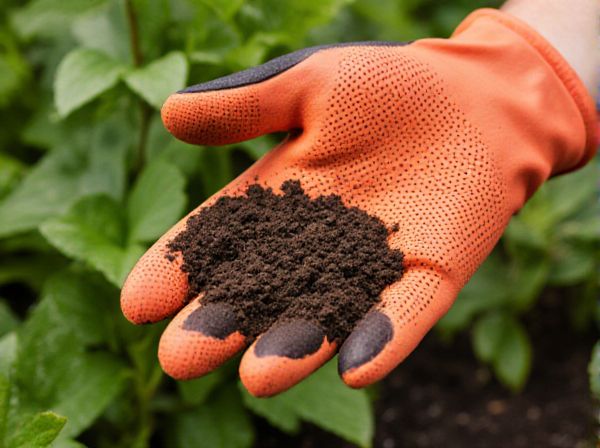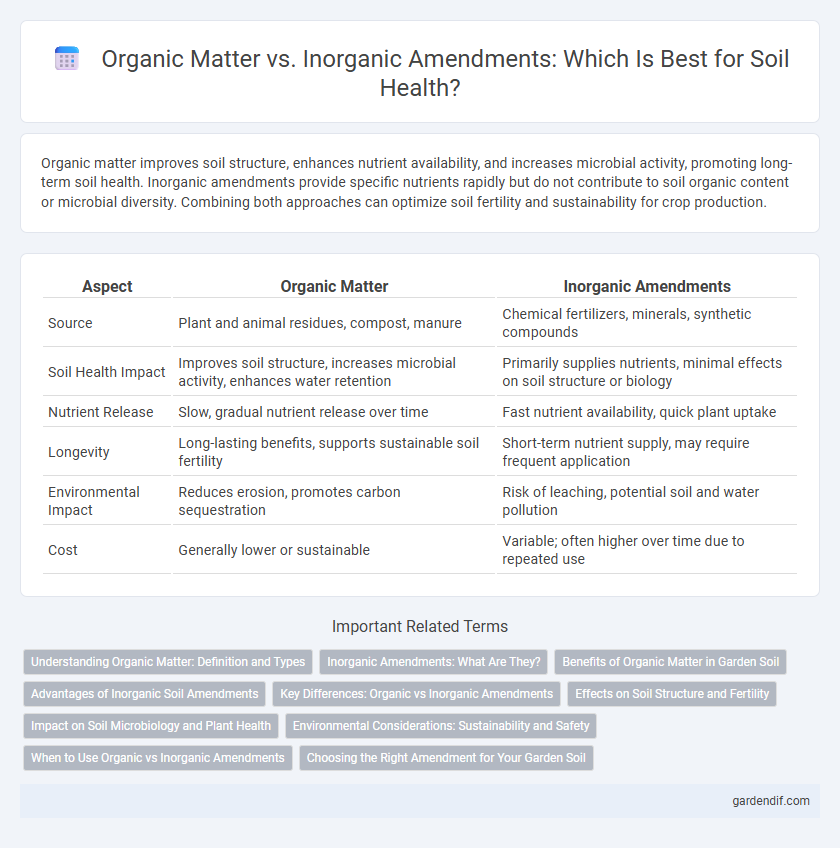
Organic Matter vs Inorganic Amendments Illustration
Organic matter improves soil structure, enhances nutrient availability, and increases microbial activity, promoting long-term soil health. Inorganic amendments provide specific nutrients rapidly but do not contribute to soil organic content or microbial diversity. Combining both approaches can optimize soil fertility and sustainability for crop production.
Table of Comparison
| Aspect | Organic Matter | Inorganic Amendments |
|---|---|---|
| Source | Plant and animal residues, compost, manure | Chemical fertilizers, minerals, synthetic compounds |
| Soil Health Impact | Improves soil structure, increases microbial activity, enhances water retention | Primarily supplies nutrients, minimal effects on soil structure or biology |
| Nutrient Release | Slow, gradual nutrient release over time | Fast nutrient availability, quick plant uptake |
| Longevity | Long-lasting benefits, supports sustainable soil fertility | Short-term nutrient supply, may require frequent application |
| Environmental Impact | Reduces erosion, promotes carbon sequestration | Risk of leaching, potential soil and water pollution |
| Cost | Generally lower or sustainable | Variable; often higher over time due to repeated use |
Understanding Organic Matter: Definition and Types
Organic matter in soil consists of decomposed plant and animal residues, microorganisms, and humus, essential for soil fertility and structure. Types of organic matter include fresh residues, decomposed material at various stages, and stable humus, each playing a distinct role in nutrient cycling and water retention. Understanding these variations aids in managing soil health and enhancing crop productivity through improved soil biology.
Inorganic Amendments: What Are They?
Inorganic amendments are synthetic or mineral-based substances added to soil to improve its physical and chemical properties, such as fertilizers containing nitrogen, phosphorus, and potassium. These amendments enhance nutrient availability and soil structure but lack the biological benefits provided by organic matter. Common examples include lime, gypsum, and synthetic fertilizers that aid in pH adjustment and nutrient supplementation for crop growth.
Benefits of Organic Matter in Garden Soil
Organic matter improves soil structure by enhancing aeration and water retention, promoting healthier root growth in garden soil. It supplies essential nutrients through slow decomposition, supporting sustained plant growth and microbial activity. Incorporating organic matter increases the soil's cation exchange capacity, boosting nutrient availability and reducing the need for chemical fertilizers.
Advantages of Inorganic Soil Amendments
Inorganic soil amendments offer precise nutrient management by providing essential minerals like nitrogen, phosphorus, and potassium in readily available forms, enhancing crop yield and growth speed. They improve soil structure and water retention without significantly altering soil pH, supporting consistent plant health. These amendments also reduce the risk of introducing pathogens or weed seeds, ensuring safer soil enhancement compared to organic matter.
Key Differences: Organic vs Inorganic Amendments
Organic amendments, such as compost and manure, enrich soil by improving its structure, moisture retention, and microbial activity through natural decomposition processes. Inorganic amendments, like chemical fertilizers and mineral additives, provide immediate nutrient availability but lack the long-term benefits of enhancing soil biology and organic content. The key difference lies in organic amendments fostering sustainable soil health, while inorganic ones offer quick nutrient boosts without improving soil organic matter.
Effects on Soil Structure and Fertility
Organic matter enhances soil structure by promoting aggregation, increasing porosity, and improving water retention, which leads to better root growth and nutrient availability. Inorganic amendments primarily supply specific nutrients but often lack the capacity to improve soil physical properties, potentially leading to compaction or reduced microbial activity. Combining organic matter with targeted inorganic fertilizers optimizes soil fertility and maintains structural integrity for sustainable crop production.
Impact on Soil Microbiology and Plant Health
Organic matter enhances soil microbiology by providing a diverse source of nutrients and energy that stimulate microbial activity and diversity, leading to improved soil structure and nutrient cycling. Inorganic amendments, such as synthetic fertilizers, deliver immediate nutrient availability but may reduce microbial diversity and soil biological activity over time. Healthy soil microbiology supported by organic matter promotes robust plant growth, disease resistance, and sustainable crop yields.
Environmental Considerations: Sustainability and Safety
Organic matter enhances soil health by improving nutrient cycling and increasing microbial activity, leading to sustainable soil fertility without chemical residues. Inorganic amendments provide rapid nutrient availability but pose risks of runoff, groundwater contamination, and soil degradation, impacting long-term environmental safety. Sustainable soil management favors organic inputs due to their ability to maintain soil structure and reduce negative ecological impacts.
When to Use Organic vs Inorganic Amendments
Organic amendments are ideal for improving soil structure, water retention, and microbial activity, particularly in long-term soil health management and garden beds. Inorganic amendments provide immediate nutrient availability and are effective in correcting specific nutrient deficiencies or pH imbalances quickly. Choosing between organic and inorganic amendments depends on the soil condition, crop requirements, and urgency of nutrient needs.
Choosing the Right Amendment for Your Garden Soil
Organic matter improves soil structure, enhances nutrient retention, and supports beneficial microbial activity, making it ideal for long-term soil health. Inorganic amendments, such as lime or gypsum, rapidly adjust specific soil properties like pH and mineral content but do not contribute to organic carbon or microbial diversity. Selecting the right amendment depends on your garden's soil test results and desired outcomes, balancing immediate soil correction with sustainable fertility.
Organic Matter vs Inorganic Amendments Infographic

 gardendif.com
gardendif.com